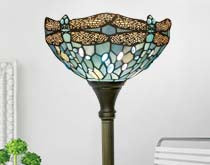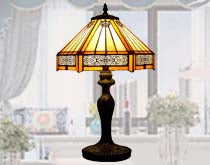Table Lamp vs. Accent Lamp: Illuminating the Differences
Lighting is not just about dispelling darkness. In-home design, the right lighting can breathe life, warmth, and style into your space. From functionality to decoration, lamps play various roles in our lives. Among the myriad of lighting fixtures, table lamps, and accent lamps are undoubtedly the most common.
But do you know the difference between them? Why do we choose table lamps for our desks and accent lamps for the corners of our living rooms? Let's delve into the charm and distinctions of these two types of lamps.
Related reading: Romantic & Unique Rose Diamond Table Lamp

Table Lamp: Definition and Features
A table lamp, as the name suggests, is a lighting device specifically designed to be placed on tables or other flat surfaces. Its core function is to provide directed and concentrated light to support various activities that require clear illumination, such as reading, writing, crafting, or painting.
Design and Structure
- Base: The base of a table lamp not only provides stability for the entire fixture but often becomes the focal point of the design. Bases can be made from various materials like metal, glass, ceramic, or wood, each bringing a unique aesthetic and style to the lamp.
- Stem: The stem, connecting the base and the shade, often comes with switches or dimmers. The design and material choice of the stem can significantly influence the overall appearance and style of the lamp.
- Shade: The primary function of the shade is to disperse and filter the light, making it softer and more uniform. Shades can be made from fabric, glass, metal, or paper, each offering a different effect and ambiance to the light.
Usage
Table lamps serve more purposes in a home than just providing light. They are a subtle yet powerful element in home design, bringing a unique ambiance and style to any space.
Task Lighting
Table lamps are the ideal choice for specific task lighting. Whether working or studying at a desk or reading by the bedside, they provide just the right amount of light, ensuring your eyes don't get fatigued from too much or too little light.
Decorative Element
The design and style of a table lamp can add extra charm to an interior space. A carefully chosen table lamp can become the focal point of a room or complement other furniture and decorations.
Ambiance Creation
By adjusting the brightness and color temperature of a table lamp, you can easily create different moods for a room. A warm light can bring a cozy and intimate feeling to your space, while a cool white light can make a room appear more spacious and bright.
Space Utilization
In smaller or narrower spaces, table lamps can serve as a space-saving lighting solution. Compared to chandeliers or floor lamps, table lamps occupy less space but deliver equally impressive lighting effects.
Flexibility
Another advantage of table lamps is their flexibility. You can easily move them as needed, whether from one room to another or from home to office.
In summary, table lamps not only offer practicality in our lives but also add style and personality to our living spaces. The right choice and use of a table lamp can make your home environment more comfortable and appealing.
Light Source and Brightness
Incandescent Bulbs: Traditional incandescent bulbs provide warm and soft light but are less efficient with a shorter lifespan.
LED Bulbs
LEDs are the preferred choice for modern lighting, being energy-efficient, long-lasting, and offering various color temperature options.
If your LED keeps flickering, you can check out our tutorial to fix the problem.
Energy-saving Bulbs
These are more energy-efficient than traditional incandescent bulbs but might take longer to reach maximum brightness.
Dimming Feature
Many modern table lamps come with a dimming feature, allowing users to adjust the brightness according to the activity and time of day, creating the perfect lighting environment.
Accent Lamp: Definition and Features
An accent lamp, as its name implies, is primarily used to add decoration and ambiance to an interior space. Unlike table lamps, which mainly provide bright light, the primary function of an accent lamp is to create a certain mood or emphasize a specific design element in a room.
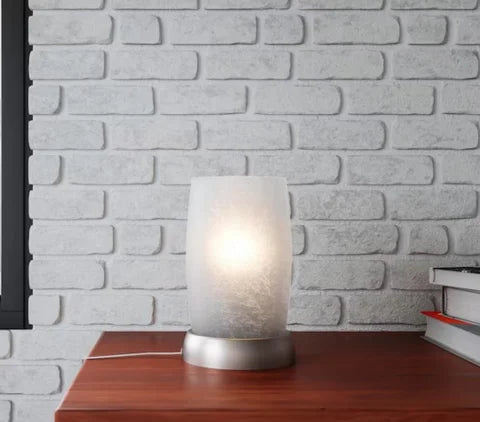
Design and Structure
Accent lamps typically have a more refined and artistic design. They can come in various shapes, sizes, and colors, ranging from simple geometric forms to intricate artworks. Structurally, accent lamps might not have the sturdy base or prominent stem of traditional table lamps, focusing more on the aesthetic appeal of the shade or the overall design.
The material choices for accent lamps are diverse, ranging from traditional ceramics and glass to modern plastics and fibers. These materials give designers more creative freedom, resulting in unique and eye-catching designs. The manufacturing process might also be simpler, as accent lamps don't need to withstand much pressure or wear.
Usage
Accent lamps are more than just a lighting tool; they play a crucial role in interior design. Here are some primary uses for accent lamps:
- Space Definition: Accent lamps can help define and segment spaces. For instance, in an open-concept living and dining room combo, an accent lamp can highlight the space above the dining table, adding a unique touch.
- Focal Point Creation: By placing an accent lamp, you can create a focal point in a room, making an artwork, piece of furniture, or decoration stand out.
- Ambiance Creation: The soft light from an accent lamp can create a warm, cozy ambiance in a room, especially during the evening or on rainy days.
- Functionality and Practicality: While primarily decorative, accent lamps can also provide the necessary light in a room, serving as a bedside lamp or reading light on a desk.
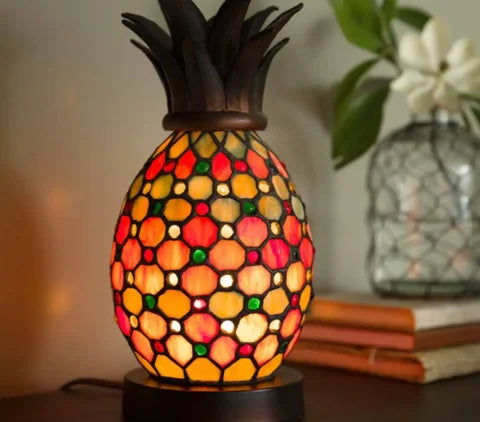
Main Differences
Functionality vs. Decorativeness
While table lamps, as functional lighting tools, aim to provide users with bright, focused light to assist in various tasks, accent lamps, though they can also provide light, mainly aim to add aesthetic and ambiance to an interior space. The design, color, and shape of accent lamps are meant to harmonize with other elements in a room, creating a unified and harmonious feel.
Size and Shape
Table lamps are generally larger, and designed to be placed on tables or other work surfaces. Their bases and stems are built for stability and to support the shade. In contrast, accent lamps are more delicate and intricate, designed to be placed on shelves, cabinets, or tables, adding light and charm to a room's nook or cranny. Those spots where a table lamp won't fit? Consider an accent lamp.
Light Distribution
The shade and light source of table lamps are designed to provide broad, uniform light, suitable for reading, writing, or other tasks requiring bright light. In contrast, accent lamps focus more on the texture and distribution of light, possibly offering softer, diffused, or directed light to create a specific mood in a room. Generally, accent lamps are not primarily for illumination.
Price and Brand
The prices of table and accent lamps are influenced by their materials, design, brand, and functionality. High-end brands and designer series accent lamps might be pricier due to their unique designs and high-quality materials. Table lamps, especially those more focused on functionality, might be more reasonably priced. Regardless, investing in the right lamp is worthwhile as it not only provides light for your home but also adds style and personality.
It's worth noting that if you want the brightness of a table lamp and the decorative function of an accent lamp, Tiffany-style lamps are an excellent choice.
Although Tiffany style lamp belong to the Art Nouveau style and are not considered decorative or accent lamps, they can be seen as decorative due to their beautiful shades. At the same time, they also provide ample light.
It's well known that Tiffany-style lamps are replicas of authentic Tiffany fixtures. Their exquisite glass shades make them endlessly charming, and their sturdy metal or resin bases have a classic style. The variety in size and style makes them suitable for every household's choice.
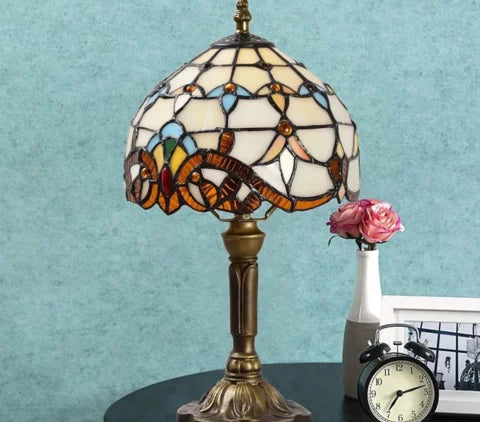
How to Choose the Right Lamp
There are many factors to consider when choosing the right lamp, as individual considerations vary. However, here are some general selection factors:
Consider the Space
When choosing a lamp, the first thing to consider is where you plan to place it. A large living room or study might require a functional, bright table lamp, while a small bedroom or hallway might be better suited for a decorative, soft-light accent lamp. Additionally, consider the size of the lamp to ensure it's proportionate to the room, neither too big nor too small.
Consider the Style
Lamps are not just lighting tools; they're essential components of interior decoration. Therefore, it's crucial to choose a lamp that harmonizes with your home decor style. Whether you prefer modern, traditional, rustic, or bohemian, there's a plethora of choices in the market. Consider the materials, colors, and design to ensure they complement your furniture and decorations.
Consider the Functionality
Modern lamps offer many functional options, such as dimming, energy-saving, and USB charging ports. Choose the right features based on your actual needs. For instance, if you often read at night, a table lamp with a dimming feature might be the best choice. If you're environmentally conscious, then an LED lamp with energy-saving options would be wise.
For more on how to choose the right lamp, this related article might help: Top 10 Tiffany Lamp Table in 2022: Ultimate Buying Guide
Conclusion
While both table lamps and accent lamps are lighting tools, they differ in functionality, design, and purpose. Table lamps focus more on functionality, providing us with bright, concentrated light to assist in various tasks. In contrast, accent lamps emphasize decoration, adding beauty and ambiance to interior spaces.
When choosing a lamp, it's essential to consider your space, style, and functional needs. Whatever your choice, ensure it harmonizes with your home decor style and meets your practical needs. Lastly, remember that choosing the right lamp can not only add charm to your home but also enhance your quality of life.












